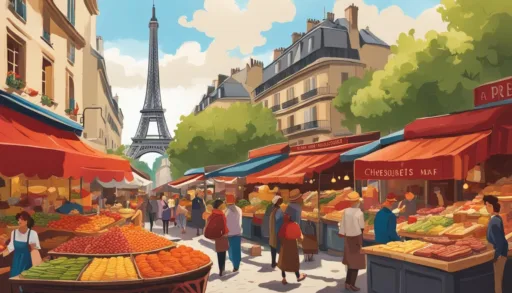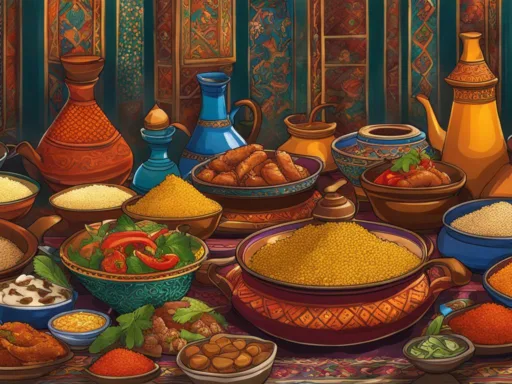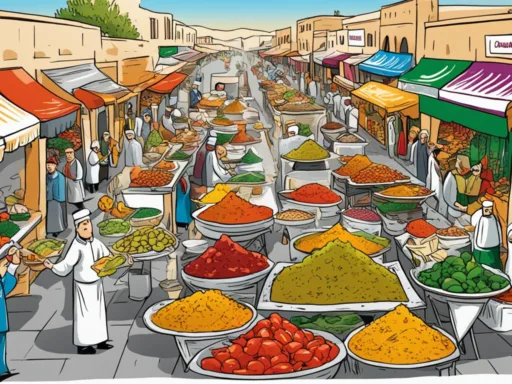Within its borders, France boasts over 5,000 years of gastronomic history, a testament to its enduring dedication to culinary excellence and its pivotal role in the art of global gastronomy. This storied past paves the way for a French Cuisine Journey that beckons food enthusiasts to an exquisite universe where each dish narrates a chapter of France’s cultural tapestry. As we embark on this cultural exploration, it’s essential to recognize that French cooking traditions extend far beyond the kitchen; they signify a passionate relationship with the culinary arts that the French have cultivated and refined across centuries.
Offering more than just an authentic dining experience, navigating through the landscape of French cuisine provides an interactive map of flavors and practices that have influenced global gastronomy on multiple levels. As we delve into the heart of culinary artistry, we uncover the layers of thought, innovation, and passion ingrained in every butter-laced, wine-reduced, and herb-infused masterpiece that is emblematic of the rich and diverse French culinary heritage.
Key Takeaways
- The depth and influence of French gastronomy within the culinary world.
- A journey through France is a sensory exploration of its rich cultural heritage.
- Understanding the historical significance behind France’s celebrated cooking techniques.
- Appreciating the role of fresh ingredients in crafting authentic French flavors.
- A glimpse into the regional diversity that shapes the country’s gastronomy.
- Discovering the art of French dishes and how they elevate the dining experience.
The Essence of French Cuisine
The heart of French cuisine is its unwavering commitment to culinary finesse and the fresh quality ingredients that elevate every dish to a work of art. Renowned for its echoes of tradition and the masterful blend of flavors, the diversity of regional French cooking guarantees a palette of tastes and textures bound together by a common thread of sophistication and culinary heritage.
As one wanders through the regions of France, the whisper of Provencal herbs, like thyme, rosemary, and parsley, float through the air, infusing dishes with fragrant qualities incomparable in their ability to transport a diner to the lavender fields under the Mediterranean sun. These herbs are not mere garnishments; they are the soul of authentic French recipes, meticulously chosen to achieve an aromatic and flavor profile that is simple yet intricate.
- Fresh thyme sprigs interlace with garlic in traditional Provençal stews.
- Generous handfuls of rosemary infuse roasting lamb with a rustic, earthy charm.
- Parsley, finely chopped, brings a burst of freshness to sauces and garnishes alike.
The lush, green pastures of Normandy contribute another layer to the tapestry of French gastronomy with their notable Normandy butters. Rich and creamy, Normandy’s contribution is a testament to the region’s lush landscape and the unparalleled quality of terroir. A smear of this golden delight across a freshly baked baguette is a moment of simple pleasure, central to the fabric of everyday French life and a testament to their full-hearted embrace of life’s gustatory pleasures.
In essence, whether one indulges in the vibrant, herbaceous flavors that hem in the Mediterranean sea or the sumptuous, creamy textures of the north’s dairy, the beauty of French cuisine lies in its respect for ingredients and the natural flavor profiles they carry — a respect that is evident in every course served and every recipe shared. It’s this unspoken allegiance to purity, quality, and harmony that crafts an immersive gastronomic experience, not only savored on the tongue but felt in the heart of all who partake.
Savoring the Regions: A Taste of French Diversity
The rich tapestry of traditional French cuisine is woven with varied threads of regional specialties, each one telling a story of the land from which it springs. As we venture through the culinary landscapes of France, we recognize the profound influence that local ingredients and historical ties have had on its regional dishes, marking each territory with distinct flavors that enchant the palate.

Provence: Olive Oils and Herbs
Bathed in the Mediterranean sun, Provence takes pride in its Provencal dishes, a sensory indulgence characterized by the liberal use of olive oil, aromatic herbs, and ripe tomatoes. The essence of Provence is best captured in simple yet sophisticated preparations that exude the freshness of the sea and the earth.
Normandy: Rich Dairy Traditions
In Normandy, dairy reigns supreme. The cool, verdant pastures produce some of the finest milk, cream, and cheese, serving as indispensable foundations for the region’s creamy sauces and butter-rich pastries. The Normandy dairy is a testament to the region’s pastoral heritage and its unwavering commitment to excellence in dairy production.
Alsace: A Fusion of Franco-German Flavors
Bordering Germany, Alsace relishes in a culinary dialectic that infuses German heartiness with French finesse. Signature dishes like Alsace sauerkraut stew, locally known as choucroute garnie, showcase a harmony of marinated cabbage and a variety of meats, marrying the pillars of Alsace’s storied gastronomic identity.
- French culinary delights – Experience the melting pot of regional flavors.
- Regional specialties – From the sunny Mediterranean to the hearty east.
- Provencal dishes – Celebrate the herbs and orchard bounty of the south.
- Normandy dairy – Indulge in the creaminess of hedgerow country.
- Alsace sauerkraut stew – Dive into the rustic Franco-German fusion.
Together, the diverse regions of France present a patchwork of gastronomy that pays homage to their unique histories and landscapes. Understanding this diversity, we begin to appreciate the vast spectrum of flavors and techniques that elevate French cuisine to a global pedestal of culinary artistry.
Celebrated French Cooking Techniques
The art of French gastronomy is renowned for its elegant and sophisticated French cooking techniques, which have been perfected over centuries. These techniques are the cornerstone of culinary exploration, allowing chefs to create gourmet French dishes that delight the senses. Prominent among these techniques are sautéing, flambé, and the innovative sous-vide, each of which contributes a unique dimension to the culinary experience.

Sautéing is a quick-cooking method that uses a small amount of fat in a hot pan to cook food rapidly, offers a perfect blend of simplicity and flavor, often resulting in a dish that’s both golden and delicious. Flambé, on the other hand, is a dramatic technique that involves adding alcohol to a dish and then igniting it to create a rich caramelized flavor. The sous-vide technique, a more modern invention, involves slow cooking food in a vacuum-sealed bag at low temperatures to achieve precise and consistent results.
Each French cooking technique, whether it’s the high-heat excitement of flambé or the patient precision of sous-vide, is a testament to France’s culinary artistry. They have transcended their origins and are now a staple in global kitchens, each imparting a touch of French excellence to dishes worldwide.
| Technique | Process | Benefits |
|---|---|---|
| Sautéing | Quick cooking in a hot pan with minimal oil | Creates a flavorful sear, preserves texture |
| Flambé | Igniting alcohol to envelop foods in flames | Introduces complex flavors, impressive presentation |
| Sous-vide | Slow cooking in a vacuum-sealed bag in water bath | Ensures even temperature, enhances natural taste |
Enthusiasts of culinary exploration can experience the depth and variety of these cooking methods in gourmet French dishes around the world. Whether it’s the tender perfection achieved through sous-vide or the rapid and flavorful results from sautéing, French cooking techniques have indisputably shaped the culinary landscape, offering endless inspiration for aspiring chefs and gourmets alike.
The Delicate Dance of French Sauces
The artful mastery of French cooking traditions is never more evident than in the delicate emulsions and roux-based creations that form the cornerstone of classic French cuisine. The mother sauces of France, with their rich history and culinary artistry, are not just accompaniments but are transformative elements that elevate the simplest dishes to haute cuisine.
Béchamel: The Creamy Delight
A velvety béchamel sauce, with its lush texture and subtle flavor, is a testament to the sophistication embedded within French culinary traditions. Originating from a roux of butter and flour, this sauce transforms when milk is whisked in, providing a creamy canvas for dishes like gratin dauphinois and lasagnes.
Hollandaise: A Touch of Elegance
The opulent hollandaise, with its bright, buttery essence, drapes vegetables and eggs in a cloak of elegance. A true embodiment of culinary artistry, hollandaise sauce requires precise technique to create its celebrated smoothness, and when mastered, echoes the grandeur of France’s gastronomic prowess.
Velouté and the Versatility of Mother Sauces
Versatile and understated, the velouté sauce is one of the most adaptable mother sauces, forming the foundation from which countless other sauces are derived. It begins with a simple roux, to which a light stock — chicken, fish, or veal — is added, allowing chefs to infuse additional flavors in pursuit of culinary perfection.
| Sauce | Base Ingredients | Common Pairings | Complexity Level |
|---|---|---|---|
| Béchamel | Butter, Flour, Milk | Gratins, Pasta Dishes | Moderate |
| Hollandaise | Egg Yolks, Butter, Lemon Juice | Vegetables, Eggs Benedict | High |
| Velouté | Butter, Flour, Light Stock | Chicken, Fish, Veal | Variable |
Exploring the complexity and grace of these sauces reveals much about the artful nuance of French cuisine, showcasing the seamless blend of tradition and evolution that has solidified France’s reputation as a culinary leader.
A History of Flavors: Traditional French Cuisine
Embarking on a French gastronomy experience is akin to leafing through a history book where each chapter is flavored with a different aspect of France’s rich gastronomic heritage. The persistence of historic culinary traditions speaks volumes about the French cuisine authenticity and collective dedication to preserving what has always been a cherished part of the national identity. It is through the timeless appeal of authentic French recipes that one can truly savor the essence of France’s culinary past.

To understand the depths of French cuisine, it’s insightful to consider the regional variance and how these pockets of unique flavors contribute to the broader narrative of France’s culinary story. Below is a table showcasing key components of traditional French cuisine and how they embody the country’s storied gastronomic past:
| Region | Ingredient | Dish | Significance |
|---|---|---|---|
| Burgundy | Wine and Beef | Beef Bourguignon | A testament to the rich sauces and slow-cooking methods emblematic of the region. |
| Lyon | Charcuterie | Saucisson de Lyon | A symbol of the city’s flair for high-quality cured meats. |
| Brittany | Seafood | Coquilles Saint-Jacques | Reveals the coastal emphasis on fresh, sea-to-table dining practices. |
| Alsace | Sauerkraut and Pork | Choucroute Garnie | An illustration of the fusion between French and German approaches to comfort food. |
In taking a gastronomic tour of France’s storied kitchens, one cannot help but appreciate the steadfast commitment to curating a French gastronomy experience that is deeply rooted in heritage. The flavors of yesteryears are not just remembered—they are revered and replicated, ensuring the legacy of France’s historic culinary traditions is enjoyed for generations to come.
French Cuisine Journey: The Global Influence of French Gastronomy
It’s undisputed that French culinary delights have etched a profound imprint on global gastronomy impact, shaping the evolution of international dining experiences. The French approach to cooking and its meticulous attention to detail transcend borders, setting the stage for a worldwide haute cuisine movement. This rich culinary influence is a testament to the prowess and innovation inherent in French gastronomic traditions.

Haute Cuisine: The Art of Fine Dining
Haute cuisine, a cornerstone of French culinary heritage, is synonymous with the fine dining experience and culinary excellence. Its rigorous standards and inventive preparation have been inspirational, setting an aspirational benchmark for chefs and diners around the world. The precision in technique and dedication to quality have empowered chefs globally to strive for perfection in their creations.
Nouvelle Cuisine: Revolutionizing Flavor and Presentation
In the realm of Nouvelle Cuisine, French chefs in the 1960s spearheaded a radical departure from traditional, heavily sauce-laden dishes in favor of lighter fare that emphasized natural flavors and innovative presentation. This movement revolutionized the French and international culinary scene, as it adhered to principles of using high-quality, locally-sourced ingredients to produce innovative dishes that are as visually appealing as they are delectable.
| Haute Cuisine | Nouvelle Cuisine |
|---|---|
| Elegant and elaborate dishes | Lighter, more refined flavor profiles |
| Emphasis on artistry and precision | Focus on natural flavors and minimalism |
| Tradition-bound classical techniques | Innovative techniques that challenge convention |
| Luxury ingredients and grand presentation | Fresh, high-quality ingredients with a focus on the intrinsic |
| Influence on fine dining globally | Impact on modern, inventive cuisine worldwide |
As we continue to revel in the delights of French cuisine, let us acknowledge its substantial contribution to the tapestry of global gastronomy. The influence of French cooking has been instrumental in shaping the tastes and preferences of food enthusiasts everywhere. From haute cuisine to Nouvelle Cuisine, France’s legacy within the culinary world continues to evolve, sparking new levels of creativity and passion in the kitchen.
Iconic French Culinary Delights to Experience
When setting foot inside a French restaurant, you’re not simply there to eat; you’re embarking on an unparalleled French gastronomy experience. The array of gourmet delights is a true testament to the finesse of French culinary artistry. Among these, *grilled courgette* charms the palate as an elegant appetizer, often paired with the creamy lavishness of burrata.
The quest for iconic gustatory pleasure doesn’t end there. A main course like the *chargrilled lamb saddle* weaves together the smoky essence of char with the tender, juicy meat, achieving a symphony of taste. And let us not forget a dish like *parmesan gnocchi*— a bold yet refined expression of pasta that marries the silky texture of gnocchi with the nutty richness of parmesan.
| Course | Dish | Signature Ingredients | Flavor Profile |
|---|---|---|---|
| Appetizer | Grilled Courgette with Burrata | Zucchini, Burrata, Olive Oil | Smokey with a buttery finish |
| Main Course | Chargrilled Lamb Saddle | Lamb, Herbs, Charred Vegetables | Rich and smokey with herbal notes |
| Pasta | Parmesan Gnocchi | Potato Gnocchi, Parmesan Cheese | Creamy and cheesy with a delicate texture |
Each dish is more than just sustenance. It is a cherished story told through layers of history and tradition, presented to satisfy the longing for an authentic taste of French elegance. Offering more than nourishment, these dishes stand as cultural landmarks on the map of world cuisine. Selecting from this rich tapestry of flavors ensures an evening of not just dining, but dining superbly — the French way.
French Gastronomy Experience: Bistro to Banquet
The essence of a French meal is not merely the sum of its delicious parts but a culinary gem cherished across generations. Each French cuisine journey embraces the storied service à la française, turning an ordinary meal into a festivity of taste and tradition.
The Art of Service à la Française
Service à la française is not just a method of dining but a spectacle of French dining rituals that unfolds across the table. This time-honored technique involves meticulously presenting platters of food from which diners serve themselves, enhancing the elegance and style of the meal.
It underlines not just the skill in preparation but also the beauty in sharing—where each dish is passed hand to hand, strengthening bonds between friends and family. In practice, service à la française transforms dining into a graceful dance of porcelain and silver, and every meal becomes a chapter in the storied narrative of French culture.
The Intangible Heritage of French Dining
Celebrated around the world and recognized as part of the UNESCO intangible cultural heritage, the French meal is a ceremonial sharing of more than just a menu—it’s the sharing of a heritage. The orchestration of the meal, from aperitif to digestif, showcases an age-old cultural experience that illuminates the refined cadence of French cuisine.
| Course | Description | Sensory Experience |
|---|---|---|
| Aperitif | A welcoming drink to stimulate the appetite. | Awakens the palate and sets a convivial mood. |
| Entrée | A light starter to begin the meal’s progression. | Prepares the senses for the flavors to come. |
| Main Course | The heart of the meal, offering depth and complexity. | Engages taste fully, showcasing the dish’s essence. |
| Fromage | An assorted selection of French cheeses. | Highlights the palate’s versatility, balancing textures and flavors. |
| Dessert | A sweet note to conclude the savory courses. | Dazzles the taste with sweetness and intricacy. |
| Digestif | After-dinner beverage to aid in digestion. | Completes the sensory journey, offering a moment of reflection. |
The tradition extends far beyond the flavors on the plate, engaging a tapestry of senses that invoke memories and forge new ones—a quintessential French gastronomy experience.
The Art and Ritual of a French Meal
The tapestry of French cooking traditions is woven with threads of ritualistic charm and culinary splendor, depicting a canvas where each meal is a celebration of life’s milestone moments. Whether it’s a simple dinner or a grand festivity, the French meal experience is steeped in a culture of connection and community, making every encounter over food a memorable one. The commencement of this ritual often begins at the very heart of the French love for food—the market.
Here, amidst vibrant stalls and the amiable chatter of producers and patrons, one garners invaluable insights into the fresh regional specialties that will grace the evening’s table. It is this preparation stage, a prelude to the meal itself, that ignites the anticipation and sets the tone for what is to come.
As the day wanes and guests arrive, the French culinary stage is set. The dining area, a meticulously arranged tableau, primes the sensory feast ahead. In France, a well-laid table is not merely a platform for dining; it is a testament to the lavish culinary culture and a gesture of welcoming. Below is a reflection of a typical setting found at such family gatherings, elevating both aesthetics and appetite:
| Element | Description | Significance |
|---|---|---|
| Table Linens | Pristine, often white tablecloths with napkins | Sets the stage for an elegant meal |
| Tableware | Exquisite porcelain dishes and polished silverware | Respects the culinary efforts and heightens the dining experience |
| Glasses | Crystal stemware for wine and water | Complements the selection of beverages and elevates flavor profiles |
| Centerpiece | Floral arrangements or candles | Adds to the visual splendor and ambiance of the meal |
In essence, to partake in a French meal is to immerse oneself in an atmosphere ripe with tradition and camaraderie. It’s not simply about the delicacies on the plate but about the shared joy and the unspoken understanding that the best moments in life are those spent together, savoring the richness of French cooking traditions.
Pichet: A Glimpse Into Modern French Cuisine
Within the heart of Dublin lies Pichet, a beacon of contemporary French cuisine that represents the evolving face of French gastronomy. This establishment seamlessly blends classic culinary techniques with innovative twists, creating an unparalleled Dublin dining experience. Diners at Pichet are treated to an array of dishes that showcase the very best of French culinary finesse, making it a standout among Michelin-starred restaurants.
Menu Exploration: A Contemporary Take on Classics
Patrons of Pichet embark on a journey of menu exploration, savoring dishes that breathe new life into timeless classics. Each item on the menu is carefully crafted to honor traditional flavors while embracing modern creativity. Here’s a glimpse of Pichet’s innovative offerings:
- Starters: A selection that melds the simplicity of local produce with complex French techniques.
- Main Courses: Hearty, flavor-rich dishes that bring forth the essence of modern French cuisine.
- Desserts: Delectable sweets that conclude the meal with finesse and flair.
Michelin Stardom: Synonymous with Quality
As a symbol of excellence, Pichet’s strong reputation among Michelin-starred restaurants is well-deserved. Awards and accolades aside, the true testimony of their dedication to quality is reflected in the smiles and satisfaction of their guests. With their consistent delivery of exceptional plates and memorable culinary encounters, Michelin stardom becomes more than a badge; it’s a promise of quality that Pichet honors with every dish.
Conclusion
Our French Cuisine Journey is more than simple culinary exploration—it is an immersive odyssey steeped in cultural heritage and the celebration of global gastronomy. France’s significant impact on the world’s culinary landscape is marked by the país’s ability to preserve traditional dishes while continually influencing contemporary tastes. The finesse of French cooking is showcased through the delicate balance of rustic regional specialties and the refined flavors found within the bustling cities’ renowned establishments.
As we’ve delved into the variegated tapestry of French gastronomy, what emerged is not just an array of gourmet delights but a deeper understanding of the meticulous culture and historical narratives that each dish represents. From Provencal herbs to Normandy butter, from the velvety complexity of a béchamel sauce to the earthy goodness of a choucroute garnie, we have witnessed firsthand the timeless elegance intrinsic to French cuisine.
In essence, to partake in the French Cuisine Journey is to allow oneself to be transported through a sensorial feast that deftly intertwines the old with the new. It is a testament to how cuisine can serve as a universal language, connecting people, places, and times. As we close this foray into French culinary vistas, we are left with a profound appreciation for the intricate artistry, boundless creativity, and passionate dedication that firmly entrench French cuisine at the heart of the culinary world.






